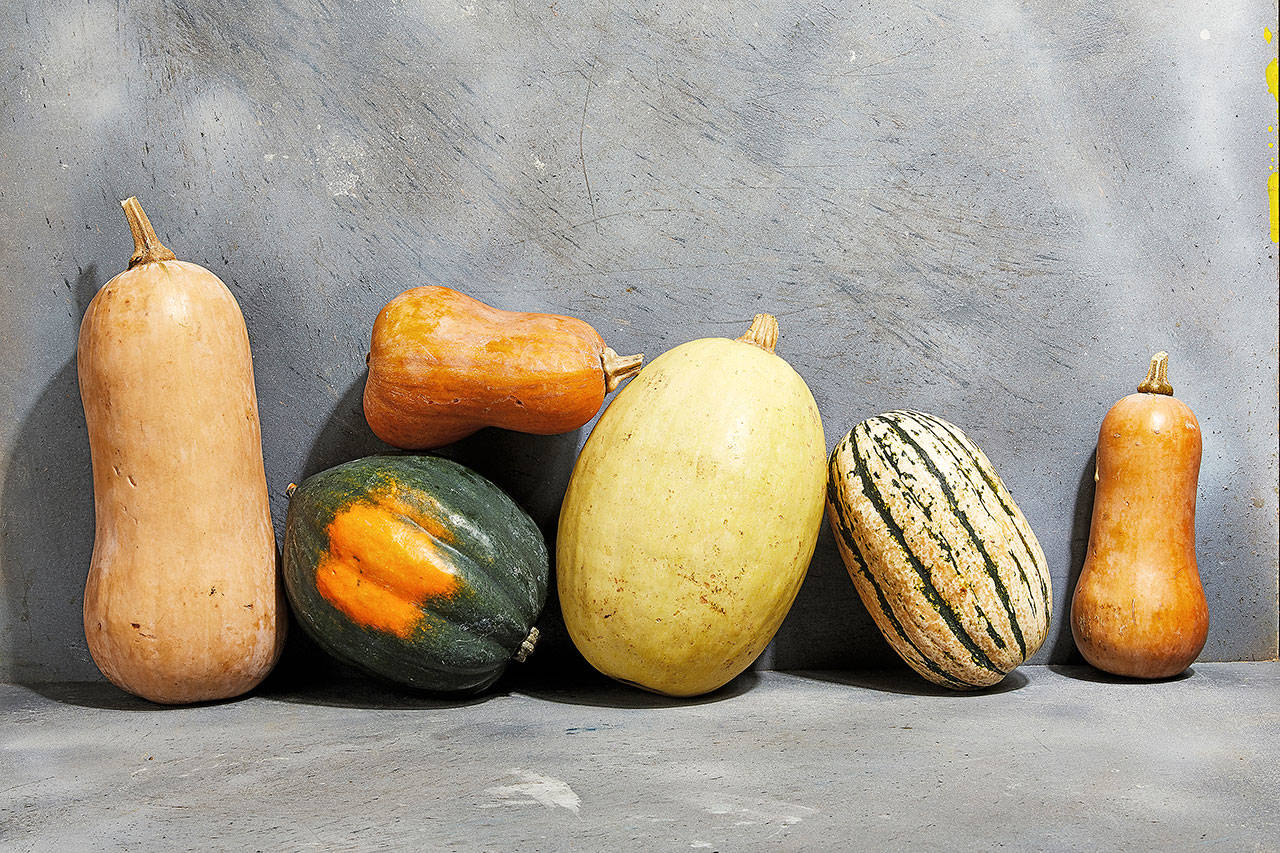By Becky Krystal / The Washington Post
It’s decorative gourd season, but it’s also edible gourd season. Swing by any farmers market these days and you’ll be greeted with a rainbow of winter squash in all sorts of shapes, sizes and colors.
They’re so tempting you might be hauling a few home before you even know what you’re going to do with them. Need a primer? Here are tips to make the most of this seasonal specialty.
Pick the right one. Look for winter squash that are hard, heavy and free of mold or too many blemishes. A deep-colored exterior is a good sign, too. Depending on what you’re making, the varieties can be somewhat interchangeable. You’re going to get a yellow to orange flesh, with varying degrees of firmness and sweetness. Kabocha, for example, are firmer and drier, so they’re great for when you want a squash to hold its shape, such as in a curry. Delicata, as the name suggests, have a thin skin that is easy to eat. Butternut and acorn are both ubiquitous and versatile, the former boasting a marked sweet flavor and the latter a more mild one. Spaghetti squash is a class in its own, with a tender flesh that separates into somewhat glassy-looking threads. The massive Hubbard makes for an impressive stuffed holiday main course. That’s just scraping the surface. When in doubt, ask your farmers market vendor, although at this time of year, many will post a guide along with their display.
Prep it. When you want or need to peel a winter squash, I’ve found that microwaving it first hugely helps. Prick the squash in a couple of spots and then nuke it for a few minutes. The exterior will soften enough to make getting the peel off easier without necessarily cooking the inside. Even if the inside doesn’t get noticeably softer, you’ll have less trouble cutting it up, too.
Speaking of cutting, this is where it can get a bit nerve-racking. Some folks recommend using a cleaver, but a) I don’t own one and b) if I did, I’d probably be too afraid to use it. If you’re in the same boat, find the biggest, sharpest knife you have and get carving. You can steady the squash on a damp dish towel, or slice a thin plank off a side or two to make it rest flat on your board (again, that will be easier to do if you’ve first popped it in the microwave). You may need to rotate the squash — carefully — as you work your knife through it rather than going straight down in one cut. If you have a butternut, separate the straight trunk from the rounded bulb end and then continue breaking it down into the size pieces you want.
However you plan to cook it, you’re going to want to take out the seeds. Most of the time I just use a large soup spoon, but my Post buddy Kara Elder recently demonstrated how well a large, shallow ice cream scoop can work, too. Whatever you use, scrape out the seeds and the stringy flesh holding them in. If you like, you can roast them. Remove as much flesh as you can, and then you can swish them in some water to get rid of even more. Don’t worry about getting every last speck. Toss with olive oil, salt, your choice of spices and roast on a baking sheet at 300 degrees or so until they’re dry, toasty and just browning.
Cook it. There are so many ways to cook winter squash. Roasting is an obvious choice. You can roast halves in the oven at 350 to 400 degrees until soft (probably close to an hour, especially for larger varieties), cut side up or down depending on whom you ask. Or chop it into pieces for a much faster bake. There’s also the microwave route, which is the logical conclusion to the peeling strategy. You just let the squash go until it’s completely soft. Steaming is another possibility. The Post’s Deputy Food editor Bonnie S. Benwick likes to slice squash, put it in a shallow glass dish with some water and cook on high in the microwave, anywhere from 4 to 7 minutes. If you’re one of the many people who now counts an Instant Pot/multicooker among your favorite kitchen appliances, it can make very quick work of a squash, whether it’s in pieces resting on the steam rack or halves nestled above some liquid.
As to what to make, you have lots of options. Use winter squash in soup, whether it’s pureed or left in chunks. Add pieces to salad and risotto. Scoop, stuff and bake. Incorporate flesh into muffins and quick breads, or use it in a pie instead of sweet potato. Slices are nice on a wintry sandwich.
Talk to us
> Give us your news tips.
> Send us a letter to the editor.
> More Herald contact information.

























